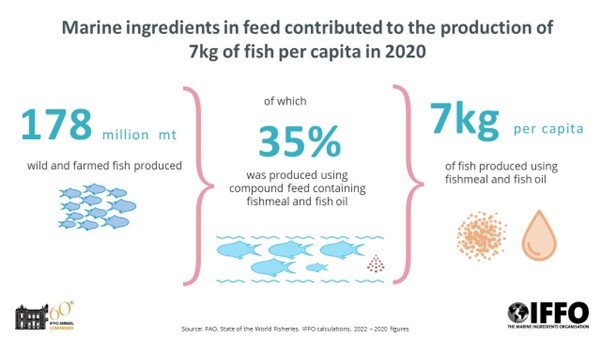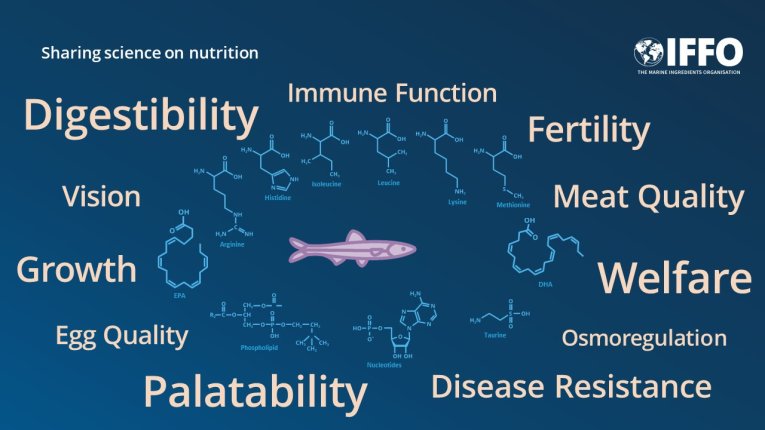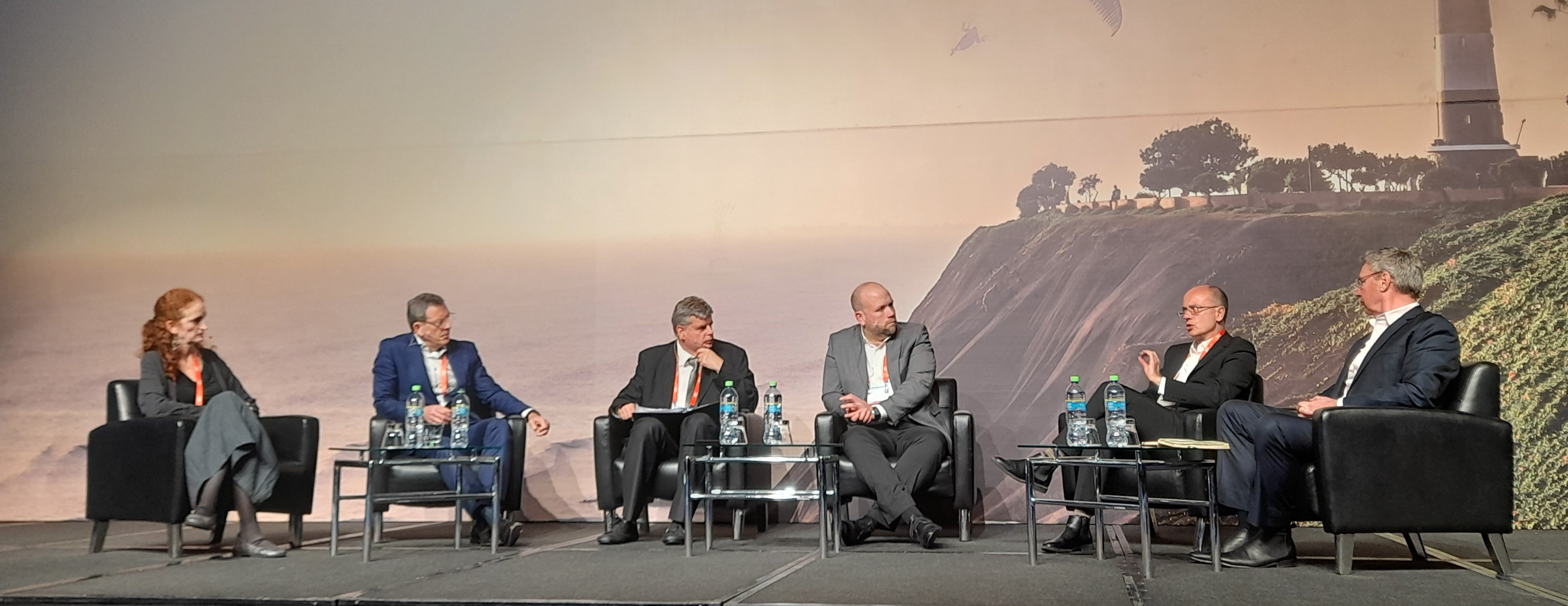IFFO’s historic 60th Annual Conference in the fishing powerhouse of Peru started on 24th of October, bringing together over 500 delegates from 35 countries, an all-time record. The detailed agenda can be found here.
The global contribution of marine ingredients
 IFFO’s President Gonzalo de Romaña opened the event by explaining the vital role of marine ingredients in the global food system. The industry has been supporting the production of food both in terms of quantity and quality, while championing responsible practices. FAO’s latest State of the World’s aquaculture and Fisheries Report (2022), states that the total production of farmed and wild fish in 2020 was 178 million mt. IFFO estimated that in 2020, 35% was tonnage farmed by using compound feed including fishmeal and fish oil. Considering that the average consumption of fish worldwide was reported at 20 kg per capita in 2020, 35% of that was produced thanks to fishmeal and fish oil. In other words, 7 kg of the 20 kg fish per capita consumed in 2020 were farmed using fishmeal and fish oil.
IFFO’s President Gonzalo de Romaña opened the event by explaining the vital role of marine ingredients in the global food system. The industry has been supporting the production of food both in terms of quantity and quality, while championing responsible practices. FAO’s latest State of the World’s aquaculture and Fisheries Report (2022), states that the total production of farmed and wild fish in 2020 was 178 million mt. IFFO estimated that in 2020, 35% was tonnage farmed by using compound feed including fishmeal and fish oil. Considering that the average consumption of fish worldwide was reported at 20 kg per capita in 2020, 35% of that was produced thanks to fishmeal and fish oil. In other words, 7 kg of the 20 kg fish per capita consumed in 2020 were farmed using fishmeal and fish oil.

Romaña remarked “This is a tremendous contribution to the production of blue foods and food security in the world at times when it is not only a question of feeding a growing population but nourishing billions with high protein nutrients.”
 The world needs marine ingredients
The world needs marine ingredients
IFFO’s Director General, Petter Martin Johannessen, noted that “a secure future relies on both nutritious and sustainable foods” and with decades of data, marine ingredients provide a benchmark for aquafeed ingredients for which the performance of other ingredients are measured. The many benefits that these valuable ingredients provide is well known and at IFFO we are extensively exploring their true contribution to the global food security.

“The role of the blue food sector in delivering nutrition should be better recognised. 70% of the world is covered by sea and fish only accounts for only 7% of all protein - It is time to make the case about blue foods as top performing in both climate and nutrition!”
To feed the world, we need to waste less fish, and with 70% of the fish often going to waste, we need to use 100%. The marine ingredients sector provides the market in which fish by-products are put to the most efficient use. Today, 30% of fishmeal and 51% of fish oil are produced from by-products. Indeed, the use of by-products currently represents one of the best bio-circularity stories in terms of capturing the full-value of animal production. “The increasing availability of sustainable marine ingredients is the only way forward to feed a growing population and more importantly, to nourish it. Quality food requires quality feed.”
Understanding this global economic crisis
 Drawing from his extensive economic expertise, the Economics Editor of the UK’s Financial Times presented a sobering overview of many economic challenges facing the world. Reaching across the globe, we can see that inflation is at its highest in 40 years, the covid crisis and then energy crisis. But this situation is different from previous crises. Country’s downturns aren’t synchronized and contagion between economies isn’t happening in the same way.
Drawing from his extensive economic expertise, the Economics Editor of the UK’s Financial Times presented a sobering overview of many economic challenges facing the world. Reaching across the globe, we can see that inflation is at its highest in 40 years, the covid crisis and then energy crisis. But this situation is different from previous crises. Country’s downturns aren’t synchronized and contagion between economies isn’t happening in the same way.
Zooming in on China, aside from Covid, another example of a continuing challenge is with shipping, with 12% of all shipping in China not moving due to bottlenecks, showing that supply chain problems are still present. Over to the US, 70% of economists believe that the US is heading for recession, with a bust after a boom scenario. In the EU, inflation has spread from the gas crisis, but the continent, like the rest of the world, is also being deeply affected by inflated food prices, which is then causing a political crisis. There are however bright spots of growth in India and Latin America, but overall global growth is falling into recession with only a 2% growth expected in 2023.
But it’s not all doom and gloom. Europe’s gas struggles and price rises have in turn cut demand, increasing reserves and resulting in a more diversified EU energy plan, it will take time. The recession following this is now unlikely to be as bad as predicted. We also now understand what is happening in the global economy, unliked what happened by in 2008 or with covid, we know that we are in the worst part, and the incoming recessions will likely be mild. The EU is managing the gas crisis and then there is always a risk with global interest rates, but they can be reduced again if gone too far.
“If I were to come back this time next year, I believe that the outlook will be a lot brighter than it is right now!” he concluded.
Collaboration as a prerequisite for sustainable development of Blue Foods
 SeaBOS’ Managing Director, Martin Exel noted that fisheries are a shared resources and what one group does directly impact another; adding that with no collaboration, sustainability is not possible. Seafood production needs to be both ecologically sustainable and economically sustainable, while building community trust. Sustainable Blue Food production is about people working together to feed our world in a healthy, sustainable, manner. Balancing the needs of society with the health of our land, ocean, and fisheries, is not for the faint-hearted, but positive action can and has occurred in our industry.
SeaBOS’ Managing Director, Martin Exel noted that fisheries are a shared resources and what one group does directly impact another; adding that with no collaboration, sustainability is not possible. Seafood production needs to be both ecologically sustainable and economically sustainable, while building community trust. Sustainable Blue Food production is about people working together to feed our world in a healthy, sustainable, manner. Balancing the needs of society with the health of our land, ocean, and fisheries, is not for the faint-hearted, but positive action can and has occurred in our industry.
Taking a structured approach, SeaBOS has identified keystone species and keystone actors to drive change, building a science-industry based collaboration stakeholder map. If you can change what their keystone actors do, then you impact the whole industry. But what is the role of marine ingredients in this? Exel called for the industry to be sustainable, responsible, climate positive, innovative; and equitable and ethical to meet society values and expectations of sustainable aquaculture.
To aid this, SeaBOS have developed a collaboration plan, including a toolkit to establish strategies and policies, action-driven measures on IUU fishing and labor abuse towards improvement, and monitoring and reporting towards transformation. Trust is the first point to the build a constructive dialogue for further change. Exel concluded by calling on the industry to be courageous and collaborate for the growth of sustainable and ethical feed production. “The seafood industry cannot thrive on an unsustainable planet, and we will not have a thriving planet with an unsustainable seafood industry.”
How to achieve truly sustainable aquaculture, fisheries and value chains
 Drawing from decades of statistical knowledge, FAO’s Stefania Vannuccini outlined a roadmap for the transformation of aquatic food systems. She noted that “food security exists when all people, at all times, have physical, social and economic access to sufficient, safe and nutritious food which meets their dietary needs and food preferences for an active and healthy life.”
Drawing from decades of statistical knowledge, FAO’s Stefania Vannuccini outlined a roadmap for the transformation of aquatic food systems. She noted that “food security exists when all people, at all times, have physical, social and economic access to sufficient, safe and nutritious food which meets their dietary needs and food preferences for an active and healthy life.”
Fisheries and the aquaculture sector have a key role in food security, providing nutritious food, employment, income and livelihood. As a superfood with an essential top nutritional source, fish provide highly bioavailable proteins and micronutrients. While the large biodiversity of fish allows for better climate adaptation options.
Production has grown to 178 million tonnes of aquatic animals, with growth in capture fisheries due to the success of fisheries management, with ‘assessed stocks’ improving and rebuilding; and unassessed stocks declining. Fisheries provide 59 million people with employment, with 600 million people depending on the sector. But challenges remain, both with resources and environment, and with socioeconomic and governance. Climate change is an increasing challenge with the maximum catch potential projected to decrease by up to 12% by 2050.
Aquatic foods are increasingly seen as part of the solution for global food security and consumption. However, growth needs to be both sustainable and equitable. The way that we produce more food cannot be at the expense of the planet. Aquaculture and capture fisheries are expected to grow, driven by both population growth and consumers choosing seafood for health. The use of fishmeal and fish oil in feed is expected to slightly decline, but they will continue to be used as strategic ingredients to improve the overall quality of the aquatic species.
Blue transformation is now under FAO’s strategic framework 2022 -2031, which will recognize successes in the sector since the 1995 Code of Conduct in combatting poverty and hunger and go on to identified priority areas to further transform aquatic foods, to develop a new vision for the sector in the 21st century.
Three objectives have been identified for a blue food transformation:
- Sustainable aquaculture intensification and expansion satisfies global demand for aquatic foods and distributes benefits equitably
- Effective management of all fisheries delivers healthy stocks and secures equitable livelihoods
- Upgraded value chains ensure the social, economic and environmental viability of aquatic food systems
Echoing early calls, collaboration was noted as key to this plan’s success, with the aim to achieve efficient, inclusive, resilient and sustainable aquatic food systems by 2030.
A prosperous and sustainable future for shrimp
 Moving to the shrimp sector, VitaPro’s Allan Cooper opened by showing the domination of shrimp and salmon in driving seafood supply growth, recently driven especially by the US market. But it is Ecuador that Cooper noted has been an unexpected success story in the shrimp sector. In 2017 Ecuador was only producing 12% of the global shrimp market, but now produces 24%, increasing by 29% in just the last year. This growth has been driven by a technological revolution, with farmers moving to automatic feeders and integrated production to packaging plants. The goal is to grow sustainably, with marine ingredients playing a critical role in this objective. This industry is also taking off in other countries, again driven by technology.
Moving to the shrimp sector, VitaPro’s Allan Cooper opened by showing the domination of shrimp and salmon in driving seafood supply growth, recently driven especially by the US market. But it is Ecuador that Cooper noted has been an unexpected success story in the shrimp sector. In 2017 Ecuador was only producing 12% of the global shrimp market, but now produces 24%, increasing by 29% in just the last year. This growth has been driven by a technological revolution, with farmers moving to automatic feeders and integrated production to packaging plants. The goal is to grow sustainably, with marine ingredients playing a critical role in this objective. This industry is also taking off in other countries, again driven by technology.
With traditional feed costs increasing, more affordable options are needed, but alternative ingredients are not yet cost competitive, but this could be reduced through economies of scale. Key focus areas for the industry are to ensure sustainable practices, validate commitment and invest in traceability technologies. And again, the key to all of this is radical collaboration for systemic change towards sustainability.
Salmon: low emission, land efficient and nutritious food source
 Moving to another dominant sector, that of salmon, Camanchaca’s CEO Ricardo García Holtz discussed the sector’s trends, opportunities, and challenges. The world has greatly changed in the last 40 years since salmon farming started, with the sector now providing the most nutritious farmed protein. With population growth, we already use 50% of the habitable land on the planet for agriculture and there is no more, unless we want to cut down the remaining forests and convert them to agricultural land. Simply put, 93% of food is produced in 10% of planet’s surface. With unhealthy lifestyles increasing mortality, seafood and salmon offer a unique range of health benefits.
Moving to another dominant sector, that of salmon, Camanchaca’s CEO Ricardo García Holtz discussed the sector’s trends, opportunities, and challenges. The world has greatly changed in the last 40 years since salmon farming started, with the sector now providing the most nutritious farmed protein. With population growth, we already use 50% of the habitable land on the planet for agriculture and there is no more, unless we want to cut down the remaining forests and convert them to agricultural land. Simply put, 93% of food is produced in 10% of planet’s surface. With unhealthy lifestyles increasing mortality, seafood and salmon offer a unique range of health benefits.
Salmon is a low emission food source, requiring less surface area and is more protein efficient than other proteins. The salmon sector has generated socio-economic development in areas where there wasn’t previously industry, with 150,000+ people employment relating to the sector in Chile. Recent trends impacting the sector include consumer changes to eating at home, and sustainable practices increasing financing. Camanchaca was the first company in Chile to have a sustainably linked loan: there is a huge opportunity here to drive sustainable growth. But growth in salmon farming is now flattening, the growth rate is now close to zero, there is demand but with lower production prices are increasing with which have consequences if not changed.
Challenges facing the sector include the global economic slowdown, feed costs, regulations and climate change. Climate change has made ocean conditions unpredictable, increasing costs by 7%. On top of this, feed costs have increased massively, energy costs have increased and regulations remain helpful to the sector.
Panel Discussion: Marine Ingredients' Role in Global Food Security
The panel was moderated by John Evans (Intrafish) and featured the sessions speakers. Discussions first opened up with China and Chris Giles noting that while the zero covid policy continues, the economy is relying on covid rates remaining low, markets will become unstable with more large lockdowns. Much of the global stress from covid was caused by a shift from services to goods, this has slowly reversed which should increase stability. With food security, the long-term situation given the demographics are reasonable, but this will depend on climate change and farming practices. Demographic projections are getting a lot smaller as fertility rates are falling, making hunger rates more manageable. The difficulty however is distribution, especially to sub-Saharan Africa. For the seafood industry, sustainability is attractive, especially in the long term. The trend is upward, but a lot is relying on finding global agreements, which is a slow process.

An area for growth in aquatic foods, is the use of by-products while also reducing waste. Martin Exel noted that collaboration was needed to aid developing regions with this. FAO is working extensively here, but government and industry need to work hard to better utilize resources noted Stefania Vannuccini. There is huge waste with the consumer and more education is needed, and marine ingredients can also go directly to the consumer.
Allan Cooper highlighted work with MarinTrust to help drive improvement with small scale producer, encouraging traceability and improving best practices along the whole supply chain. The use of marine ingredients in shrimp is sustainable, but we must keep improving and help the small companies grow sustainably, he said.








